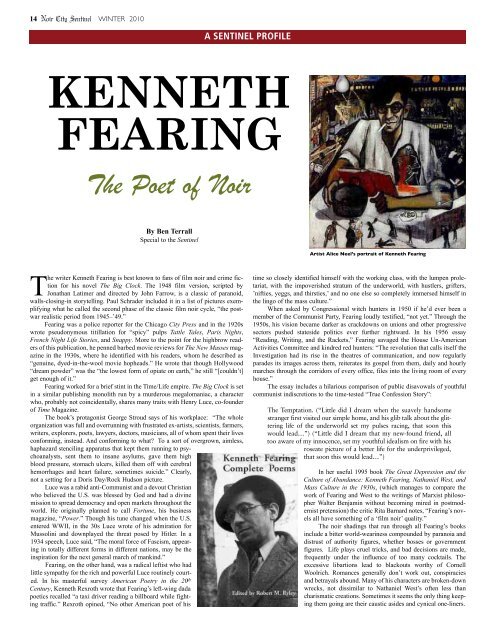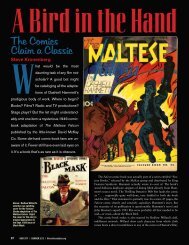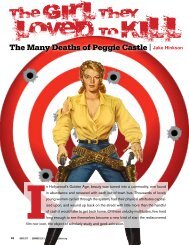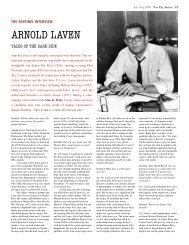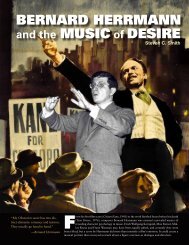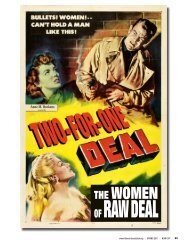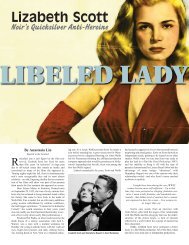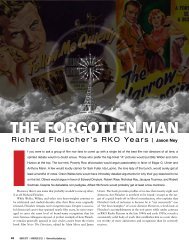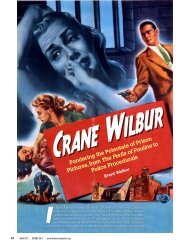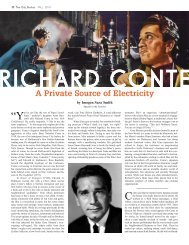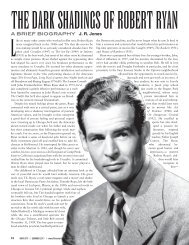Kenneth Fearing, the Poet of Noir - Film Noir Foundation
Kenneth Fearing, the Poet of Noir - Film Noir Foundation
Kenneth Fearing, the Poet of Noir - Film Noir Foundation
You also want an ePaper? Increase the reach of your titles
YUMPU automatically turns print PDFs into web optimized ePapers that Google loves.
14 <strong>Noir</strong> City Sentinel WINTER 2010<br />
The writer <strong>Kenneth</strong> <strong>Fearing</strong> is best known to fans <strong>of</strong> film noir and crime fiction<br />
for his novel The Big Clock. The 1948 film version, scripted by<br />
Jonathan Latimer and directed by John Farrow, is a classic <strong>of</strong> paranoid,<br />
walls-closing-in storytelling. Paul Schrader included it in a list <strong>of</strong> pictures exemplifying<br />
what he called <strong>the</strong> second phase <strong>of</strong> <strong>the</strong> classic film noir cycle, “<strong>the</strong> postwar<br />
realistic period from 1945–’49.”<br />
<strong>Fearing</strong> was a police reporter for <strong>the</strong> Chicago City Press and in <strong>the</strong> 1920s<br />
wrote pseudonymous titillation for “spicy” pulps Tattle Tales, Paris Nights,<br />
French Night Life Stories, and Snappy. More to <strong>the</strong> point for <strong>the</strong> highbrow readers<br />
<strong>of</strong> this publication, he penned barbed movie reviews for The New Masses magazine<br />
in <strong>the</strong> 1930s, where he identified with his readers, whom he described as<br />
“genuine, dyed-in-<strong>the</strong>-wool movie hopheads.” He wrote that though Hollywood<br />
“dream powder” was <strong>the</strong> “<strong>the</strong> lowest form <strong>of</strong> opiate on earth,” he still “[couldn’t]<br />
get enough <strong>of</strong> it.”<br />
<strong>Fearing</strong> worked for a brief stint in <strong>the</strong> Time/Life empire. The Big Clock is set<br />
in a similar publishing monolith run by a murderous megalomaniac, a character<br />
who, probably not coincidentally, shares many traits with Henry Luce, co-founder<br />
<strong>of</strong> Time Magazine.<br />
The book’s protagonist George Stroud says <strong>of</strong> his workplace: “The whole<br />
organization was full and overrunning with frustrated ex-artists, scientists, farmers,<br />
writers, explorers, poets, lawyers, doctors, musicians, all <strong>of</strong> whom spent <strong>the</strong>ir lives<br />
conforming, instead. And conforming to what? To a sort <strong>of</strong> overgrown, aimless,<br />
haphazard stenciling apparatus that kept <strong>the</strong>m running to psychoanalysts,<br />
sent <strong>the</strong>m to insane asylums, gave <strong>the</strong>m high<br />
blood pressure, stomach ulcers, killed <strong>the</strong>m <strong>of</strong>f with cerebral<br />
hemorrhages and heart failure, sometimes suicide.” Clearly,<br />
not a setting for a Doris Day/Rock Hudson picture.<br />
Luce was a rabid anti-Communist and a devout Christian<br />
who believed <strong>the</strong> U.S. was blessed by God and had a divine<br />
mission to spread democracy and open markets throughout <strong>the</strong><br />
world. He originally planned to call Fortune, his business<br />
magazine, “Power.” Though his tune changed when <strong>the</strong> U.S.<br />
entered WWII, in <strong>the</strong> 30s Luce wrote <strong>of</strong> his admiration for<br />
Mussolini and downplayed <strong>the</strong> threat posed by Hitler. In a<br />
1934 speech, Luce said, “The moral force <strong>of</strong> Fascism, appearing<br />
in totally different forms in different nations, may be <strong>the</strong><br />
inspiration for <strong>the</strong> next general march <strong>of</strong> mankind.”<br />
<strong>Fearing</strong>, on <strong>the</strong> o<strong>the</strong>r hand, was a radical leftist who had<br />
little sympathy for <strong>the</strong> rich and powerful Luce routinely courted.<br />
In his masterful survey American <strong>Poet</strong>ry in <strong>the</strong> 20 th<br />
Century, <strong>Kenneth</strong> Rexroth wrote that <strong>Fearing</strong>’s left-wing dada<br />
poetics recalled “a taxi driver reading a billboard while fighting<br />
traffic.” Rexroth opined, “No o<strong>the</strong>r American poet <strong>of</strong> his<br />
A SENTINEL PROFILE<br />
KENNETH<br />
FEARING<br />
The <strong>Poet</strong> <strong>of</strong> <strong>Noir</strong><br />
By Ben Terrall<br />
Special to <strong>the</strong> Sentinel<br />
Artist Alice Neel’s portrait <strong>of</strong> <strong>Kenneth</strong> <strong>Fearing</strong><br />
time so closely identified himself with <strong>the</strong> working class, with <strong>the</strong> lumpen proletariat,<br />
with <strong>the</strong> impoverished stratum <strong>of</strong> <strong>the</strong> underworld, with hustlers, grifters,<br />
’nifties, yeggs, and thirsties,’ and no one else so completely immersed himself in<br />
<strong>the</strong> lingo <strong>of</strong> <strong>the</strong> mass culture.”<br />
When asked by Congressional witch hunters in 1950 if he’d ever been a<br />
member <strong>of</strong> <strong>the</strong> Communist Party, <strong>Fearing</strong> loudly testified, “not yet.” Through <strong>the</strong><br />
1950s, his vision became darker as crackdowns on unions and o<strong>the</strong>r progressive<br />
sectors pushed stateside politics ever fur<strong>the</strong>r rightward. In his 1956 essay<br />
“Reading, Writing, and <strong>the</strong> Rackets,” <strong>Fearing</strong> savaged <strong>the</strong> House Un-American<br />
Activities Committee and kindred red hunters: “The revolution that calls itself <strong>the</strong><br />
Investigation had its rise in <strong>the</strong> <strong>the</strong>atres <strong>of</strong> communication, and now regularly<br />
parades its images across <strong>the</strong>m, reiterates its gospel from <strong>the</strong>m, daily and hourly<br />
marches through <strong>the</strong> corridors <strong>of</strong> every <strong>of</strong>fice, files into <strong>the</strong> living room <strong>of</strong> every<br />
house.”<br />
The essay includes a hilarious comparison <strong>of</strong> public disavowals <strong>of</strong> youthful<br />
communist indiscretions to <strong>the</strong> time-tested “True Confession Story”:<br />
The Temptation. (“Little did I dream when <strong>the</strong> suavely handsome<br />
stranger first visited our simple home, and his glib talk about <strong>the</strong> glittering<br />
life <strong>of</strong> <strong>the</strong> underworld set my pulses racing, that soon this<br />
would lead…”) (“Little did I dream that my new-found friend, all<br />
too aware <strong>of</strong> my innocence, set my youthful idealism on fire with his<br />
roseate picture <strong>of</strong> a better life for <strong>the</strong> underprivileged,<br />
that soon this would lead…”)<br />
In her useful 1995 book The Great Depression and <strong>the</strong><br />
Culture <strong>of</strong> Abundance: <strong>Kenneth</strong> <strong>Fearing</strong>, Nathaniel West, and<br />
Mass Culture in <strong>the</strong> 1930s, (which manages to compare <strong>the</strong><br />
work <strong>of</strong> <strong>Fearing</strong> and West to <strong>the</strong> writings <strong>of</strong> Marxist philosopher<br />
Walter Benjamin without becoming mired in postmodernist<br />
pretension) <strong>the</strong> critic Rita Barnard notes, “<strong>Fearing</strong>’s novels<br />
all have something <strong>of</strong> a ‘film noir’ quality.”<br />
The noir shadings that run through all <strong>Fearing</strong>’s books<br />
include a bitter world-weariness compounded by paranoia and<br />
distrust <strong>of</strong> authority figures, whe<strong>the</strong>r bosses or government<br />
figures. Life plays cruel tricks, and bad decisions are made,<br />
frequently under <strong>the</strong> influence <strong>of</strong> too many cocktails. The<br />
excessive libartions lead to blackouts worthy <strong>of</strong> Cornell<br />
Woolrich. Romances generally don’t work out, conspiracies<br />
and betrayals abound. Many <strong>of</strong> his characters are broken-down<br />
wrecks, not dissimilar to Nathaniel West’s <strong>of</strong>ten less than<br />
charismatic creations. Sometimes it seems <strong>the</strong> only thing keeping<br />
<strong>the</strong>m going are <strong>the</strong>ir caustic asides and cynical one-liners.
All <strong>of</strong> <strong>Fearing</strong>’s novels are told from multiple points <strong>of</strong> view. Clark Gifford’s<br />
Body, brought back into print along with The Big Clock by <strong>the</strong> prestigtious “New<br />
York Review <strong>of</strong> Books Classics” imprint, is <strong>Fearing</strong>’s most experimental book.<br />
Published in 1942, it describes <strong>the</strong> planning and aftermath <strong>of</strong> <strong>the</strong> armed takeover<br />
<strong>of</strong> a small town-radio station from <strong>the</strong> perspective <strong>of</strong> more than twenty different<br />
narrators.<br />
The Crozart Story, published in 1960, is packed with characters so devious<br />
that a search for redeeming character traits is fairly pointless. These operators toil<br />
in public relations for powerful commercial and political interests at a company<br />
specializing in spreading misinformation and smears. A product <strong>of</strong> countless merg-<br />
WINTER 2010 <strong>Noir</strong> City Sentinel 15<br />
ers, <strong>the</strong> firm is called United Great Famous Artists <strong>of</strong> <strong>the</strong> World, Inc. “Plant <strong>the</strong>m<br />
and slant <strong>the</strong>m” is how one <strong>of</strong> its operatives describes a job <strong>of</strong> dubious “news”<br />
leaks and spin control. Sort <strong>of</strong> as if Mad Men was scripted by Phillip K. Dick in<br />
his pre-sci-fi, but still plenty paranoid, social realist years, with more attention to<br />
polished prose.<br />
By all accounts awful at handling money, in a few years <strong>Fearing</strong> burned<br />
through <strong>the</strong> significant chunk <strong>of</strong> cash he received from <strong>the</strong> movie sale <strong>of</strong> The Big<br />
Clock, and never hit again with a sale to Hollywood. Too bad for us. After too<br />
many years <strong>of</strong> chain-smoking and heavy drinking, <strong>Fearing</strong> died one month shy <strong>of</strong><br />
his 59th birthday in 1961.


